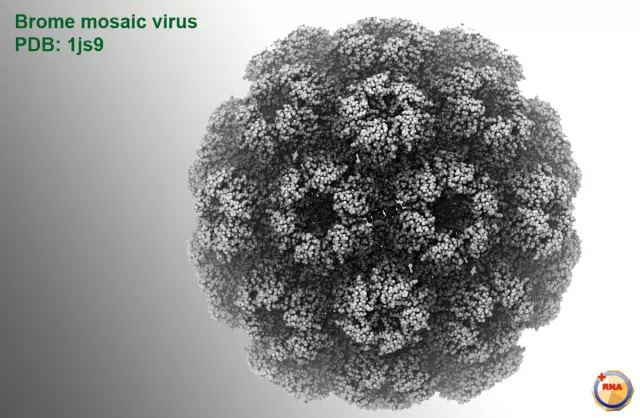- Author Curtis Blomfield [email protected].
- Public 2023-12-16 20:44.
- Last modified 2025-01-23 17:01.
The structure of viruses is non-cellular, since they do not have any organelles. In a word, it is a transitional stage between dead and living matter. Viruses were discovered by the Russian biologist D. I. Ivanovsky in 1892 in the process of considering the mosaic disease of tobacco. The entire structure of viruses is RNA or DNA enclosed in a protein shell called a capsid. A virion is a formed infectious particle.
Influenza or herpes viruses have an additional lipoprotein envelope that arises from the cytoplasmic membrane of the host cell. Viruses are divided into DNA-containing and RNA-containing, because they can have only 1 type of nucleic acid. However, the vast majority of viruses are RNA-containing. Their genomes are single-stranded and double-stranded. The internal structure of viruses allows them to multiply only in the cells of other organisms, and nothing else. They do not show any extracellular vital activity at all. The sizes of widespread viruses are from 20 to 300 nm in diameter.
The structure of bacteriophage viruses
Viruses that infect bacteria from the inside,are called bacteriophages (phages). They are able to penetrate the bacterial cell and destroy it.

The body of the Escherichia coli bacteriophage has a head, from which a hollow rod comes out, wrapped in a sheath of contractile protein. At the end of this rod is a basal plate, on which 6 threads are attached. Inside the head is a DNA molecule. With the help of special processes, the bacteriophage virus is attached to the body of the bacterium Escherichia coli. Using a special enzyme, the phage dissolves the cell wall and penetrates inside. Further, a DNA molecule is ejected from the channel of the rod due to contractions of the head, and literally after 15 minutes the bacteriophage completely rearranges the metabolism of the bacterial cell in the way it needs. The bacterium stops synthesizing its DNA - it now synthesizes the nucleic acid of the virus. All this ends with the appearance of about 200-1000 phage individuals, and the bacterial cell is destroyed. All bacteriophages are divided into virulent and temperate. The latter do not replicate in the bacterial cell, while the virulent ones form a generation of individuals in an already infected area.
Viral diseases
The structure and vital activity of viruses is determined by the fact that they can only exist in the cells of other organisms. Having settled in any cell, the virus can cause serious illness. Often agricultural plants and animals are attacked by them. These diseases sharply worsen the fertility of crops and are the cause of numerous deaths of animals.

There are viruses that can cause various diseases in humans. Everyone knows such diseases as smallpox, herpes, influenza, polio, mumps, measles, jaundice and AIDS. All of them arise due to the activity of viruses. The structure of the smallpox virus is almost the same as the structure of the herpes virus, since they are included in the same group - Herpes Virus, which includes some other types of viruses. Nowadays, the human immunodeficiency virus (HIV) is actively spreading. How to overcome it, no one knows yet.






